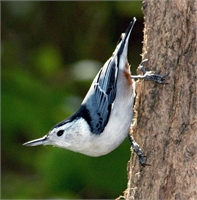This woolen wren house is one of four nesting cavities that I have on my back deck. The real purpose is to attract Carolina Wrens, which have nested on the deck before. This nest was given to us at Christmas, and we just put it out a few days ago.
Of course, nature has other ideas. What you are seeing here is a tufted titmouse stealing wool from the side of the nest to carry off to its own nesting project. I shot the photo through a window -- that's why it is a little fuzzy. I understand that these birds will actually steal the hair off a dog due to their preference for soft nesting materials. I have not seen this in action, but I am sure my dog would not tolerate such a taking.
Look at that little fuzz-puller. The tufted titmouse is a very friendly bird who typically coexists in feeding groups with birds of other species quite well. The "alliance" birds I am most familiar with in my neck of the woods are the titmouse, white-breasted nuthatch (see previous post), downy woodpecker, house finch and the red-bellied woodpecker. Throw a cardinal in there, too, for good measure. All of these birds like the kind of habitat we have: the edge of a wooded area.
I might have helped to breed this bird on the photo. Last year, after putting up about 13 bluebird houses at Don Roberts Elementary, I put another house up across the street from my house in an empty lot. Within days it became nested by a family of tufted titmice (Titmouses? Titmeeces?). Plus, the titmouse usually spends its entire life not far from the place where they were born. Because I was checking my bluebird nests every week (you can do that with bluebirds right up until the babies hatch) I found the titmouse eggs, which are cream-colored with spots of purple or brown. I learned today that on occassion, one of the birds born the year before will hang around to help its parents raise the new young.
It's a real joy to watch young birds feed that you helped nurture. I have seen first-hand how the variety and number of birds you see in your yard grows not only by the amount of food you put out, but by the opportunities you give them to raise their young.
The titmouse is extremely gregarious, like the nuthatch. I can stand two feet away from my feeder and get a close-up view of the bird in action while he eats. They have even been known to perch on a window and look into the house to watch what humans are doing.
Although the titmouse doesn't particularly freak out around other birds, they are very careful on their approach to the feeder. You can watch them fly to a branch within 20 feet or so, scout the feeder, then fly in. Then they will usually fly back into cover to eat the morsel.
The tufted titmouse needs rain, and the species is most common in areas where at least 32 inches of rain falls per year. And finally, the fact you have all been waiting for: A group if titmice are referred to as a "banditry" or a "dissimulation."







